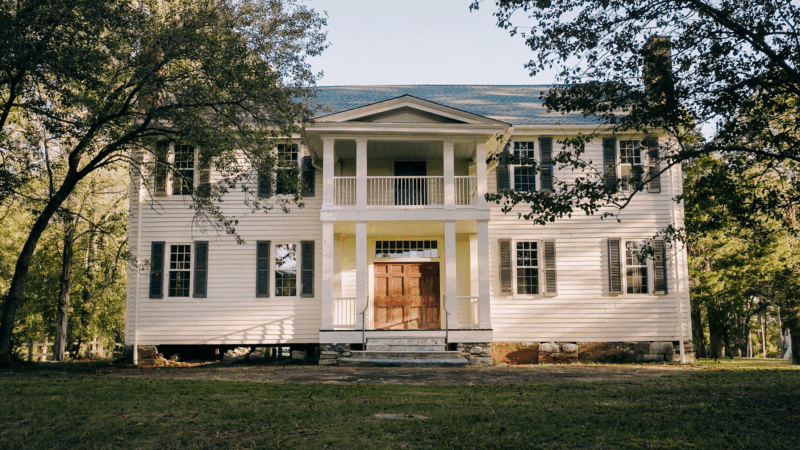A former plantation becomes a space for healing, art and reparative history
Harpersville is a small town in Alabama.
It’s predominantly white. It’s located in Shelby County, which the local Republican Party calls the reddest county in America. It’s also home to a new museum exhibit about a particular chapter of Black history. About what happened in Harpersville after formerly enslaved people were emancipated, granted their freedom — and not much else.
NPR’s Picture Show spoke with Tyler Jones who is part of a narrative studio based in Birmingham called 1504. They have been collaborating with the Wallace Center for Arts and Reconciliation to recenter the stories of Black descendant communities through creative, embodied storytelling.
With a growing network of designers, historians and local leaders, they are exploring participatory forms of interpretation that invite people to feel, not just understand, the weight of this place.
What inspired you to take on this project, and what did you hope it would achieve? Why was this the right time and place for a reparative history project using art?
Across the South, antebellum sites are often romanticized, obscuring the brutal realities of enslaved labor that made that era — and its wealth — possible. But something remarkable is happening in rural Alabama, where a plantation from 1841 is being reimagined not as a monument to the past, but as a space for reparative history and healing.
At a time when so much public discourse is fractured and politicized, art offers a deeper, more human way in. What better time and place to try connecting with a new generation around the importance of seeing history as the story of our shared humanity?
How did local residents, particularly descendants of both the enslaved and the enslavers, engage with the project? Were there collaborative aspects in the creation of the installation?
In The Praise House, we documented the making of a site-specific sculpture by Tony M. Bingham that memorializes the hidden history of “hush harbors,” gathering places where enslaved people worshiped, grieved and resisted. It stands as a tribute to the local Black church and ancestral resilience.
The broader Healing History initiative brought together descendants of enslavers and the enslaved in dialogue to practice honest, often difficult conversation. Those exchanges revealed a deep hunger for acknowledgment and the importance of not minimizing the horrors of racial violence while also not reducing the Black experience to stories of trauma.
That kind of work doesn’t happen in isolation. It depends on cultural infrastructure — organizations like the Wallace Center and the Alabama Humanities Alliance — that are willing to stand in the tension and build something enduring, even amid funding challenges and political resistance.
What has been the response from the community to the installation? Have there been any notable stories that highlight its impact?
The response has been deeply moving. At the new exhibit “Out of Whole Cloth,” curated by Dr. Elijah Gaddis and designed by Robert Finkel from Auburn University, everyday objects tell the extraordinary stories of three families of free people in post-Emancipation Alabama striving to make a place for themselves.

At the opening, Salaam Green, Birmingham’s first poet laureate, facilitated rituals alongside members of the descendant community. These weren’t symbolic performances; they were acts of remembrance and reclamation.

Seeing members of the descendent community step into the Wallace House and encounter artifacts and hold photographs from their family history was a reminder of the power of storytelling — to stitch together memory, to make history personal, and to reflect human dignity.

“Out of Whole Cloth” is free and open to the public through November by appointment here.
Auburn fires coach Hugh Freeze following 12th loss in his last 15 SEC games
The 56-year-old Freeze failed to fix Auburn’s offensive issues in three years on the Plains, scoring 24 or fewer points in 17 of his 22 league games. He also ended up on the wrong end of too many close matchups, including twice this season thanks partly to questionable calls.
In a ‘disheartening’ era, the nation’s former top mining regulator speaks out
Joe Pizarchik, who led the federal Office of Surface Mining Reclamation and Enforcement from 2009 to 2017, says Alabama’s move in the wake of a fatal 2024 home explosion increases risks to residents living atop “gassy” coal mines.
‘It’s like feeling the arms of your creator just wrapped around you’: a visit to a special healing Shabbat
Members of Temple Emanu-El in Birmingham gathered recently for their traditional Friday Shabbat service. But this particular service was different, as could be seen by all the people dressed in their finest pink.
Space Command is coming to Huntsville. What might that mean for first-time homebuyers
While Huntsville has been a more affordable market than other growing cities, what’s it been like for those looking for their first home?
Colorado says relocation of Space Command to Alabama is ‘punishment’ for mail-in voting
The litigation announced by Colorado Attorney General Phil Weiser asks a federal judge to block the move as unconstitutional.
Breaking down Alabama’s CHOOSE Act
It’s been a year since Alabama legislators passed the CHOOSE Act allowing families to apply for state funds to use towards homeschool expenses and tuition for participating private schools. The Alabama Daily News’ education reporter Trisha Powell Crain has been diving into how the funds are being used. WBHM’s Andrew Gelderman sat down with her to talk about what we’re seeing so far.









